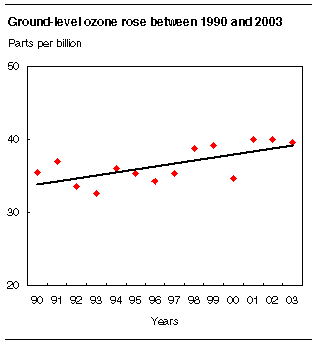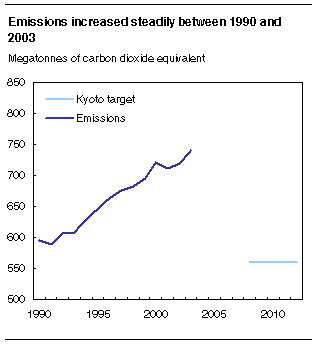
















 |
|
 |                |
Information identified as archived is provided for reference, research or recordkeeping purposes. It is not subject to the Government of Canada Web Standards and has not been altered or updated since it was archived. Please "contact us" to request a format other than those available.

|

Wednesday, December 14, 2005 Canadian Environmental Sustainability Indicators2005Trends for air quality and greenhouse gas emissions both deteriorated between 1990 and 2003, according to a new report on Canada's environmental sustainability. The report also shows that water quality pollutant guidelines for aquatic life are being exceeded, at least occasionally, at most of a selected number of monitoring sites across the country. The report, prepared by Environment Canada, Statistics Canada and Health Canada, establishes three indicators: freshwater quality, air quality and greenhouse gas emissions. They are a basis for providing Canadians with more regular and reliable information on the state of their environment and how it is linked with human activities. 
These three environmental sustainability indicators are intended as annual measuring sticks by which governments and the public can track progress in striving for cleaner water, cleaner air and lower greenhouse gas emissions. The water indicator documents the state of freshwater quality for aquatic life at selected sites across Canada. The air indicator reports national and regional trends in ground-level ozone, a key component of smog. The greenhouse gas indicator describes the trend in emissions and the contribution to emissions from energy production, energy consumption and other factors. For each indicator, the report presents the latest status and, where possible, the trends over time. It offers interpretations of what the indicator trends mean and describes the plans for future improvements. The report also discusses how the indicators are linked. Urban air quality under pressureThe air quality indicator presented in the report assesses human exposure to ground-level ozone, a key component of smog. The national concentration of ground-level ozone increased 16% from 1990 to 2003. Ground-level ozone is one of the most common and harmful air pollutants to which people are exposed. The highest levels in 2003 were all recorded at stations in Southern Ontario; concentrations in this region also grew the fastest between 1990 and 2003. In general, the health effects of ozone worsen as concentrations increase. Ground-level ozone has been linked to human health effects ranging from minor respiratory problems to emergency room visits and hospitalizations. Children, the elderly and those with pre-existing health conditions are most sensitive to high ozone levels. Related economic effects include absenteeism, lower labour force participation and increased health care costs.
The indicator is adjusted for the number of people living near air quality monitoring stations. It uses a seasonal average to account for long-term health effects. The pollutants that lead to ground-level ozone (nitrogen oxides and volatile organic compounds) are emitted when fossil fuels are burned, mainly in motor vehicles and thermal-electric power plants. Weather conditions and the movement of pollutants from other regions also affect ozone concentrations in a given locale. Greenhouse gas emissions increasingThe greenhouse gas indicator presented in the report estimates Canada's total emissions of the six greenhouse gases that are the major contributors to climate change. The indicator comes from data compiled by Environment Canada. Greenhouse gas emissions rose 24% from 1990 to 2003, and in 2003 were 32% above the target set by the Kyoto Protocol for 2008 to 2012. Alberta and Ontario had the highest emissions of all provinces in 2003. Saskatchewan, New Brunswick and Alberta had the highest percentage increases in emissions compared with 1990. Canada's emissions per unit of economic activity (as measured by gross domestic product) dropped 13% from 1990 to 2003. Efficiency improvements in the energy sector partly explain this decline. 
Energy production and consumption accounted for 81% of total Canadian greenhouse gas emissions in 2003 and 91% of the growth in emissions from 1990 to 2003. Road transportation, thermal-electric power generation and fossil fuel production were the principal sources of the increase in emissions. Road transportation accounted for 19% of total emissions in 2003 and 23% of the growth in emissions from 1990. In part, this reflects a shift in the types of vehicles used for personal transportation from automobiles to vans, sport utility vehicles and light-duty trucks. These heavier vehicles emit on average 40% more greenhouse gases per kilometre than do automobiles. The emissions from thermal-electric power generation accounted for 18% of total emissions in 2003 and 27% of the growth from 1990. This growth was driven by the rising demand for electricity and the relative increase in the use of fossil fuels, particularly coal, for electricity generation. Fossil fuel production accounted for 10% of total greenhouse gas emissions in 2003 and 13% of the growth since 1990. Between 1990 and 2003, exports of crude oil increased nearly six-fold, while exports of natural gas more than doubled. These increases explain about one-half of the total emissions increase for this category. Freshwater quality unevenThe water quality indicator provides a preliminary assessment of surface freshwater quality regarding the protection of aquatic life such as plants, invertebrates and fish. The indicator assesses freshwater quality status from 2001 to 2003. It does not assess the quality of water for human consumption. For the 345 sites selected across the country, water quality at 44% of the sites was rated as "excellent" or "good"; that is, it rarely failed to meet water quality guidelines that set recommended limits for pollutant levels. Among the remaining sites, 31% were rated as "fair"; that is, they exceeded guidelines occasionally. About 25% were rated as "marginal" or "poor"; that is, they exceeded the guidelines often or by a considerable margin. Almost all of the selected monitoring sites were in southern Canada, typically in places where water quality has been a concern. Every day, industries, institutions and households discharge hundreds of different substances directly or indirectly into rivers and lakes. At least 100,000 tonnes of toxic pollutants were directly discharged to Canada's surface waters in 2003. 
Water quality experts often identify urban development and agricultural activities as key potential causes of degraded water quality. Pulp and paper facilities, mines (including oil sands), forestry, acid rain, and dams are also considered important stresses at some sites. The following publications are now available for free online. Canadian Environmental Sustainability Indicators (16-251-XWE, free) is now available. Canadian Environmental Sustainability Indicators: Highlights (16-252-XWE, free) presents key findings from the Canadian Environmental Sustainability Indicators report. Canadian Environmental Sustainability Indicators: Socio-economic Information (16-253-XWE, free) provides contextual information on some of the main human activities that influence the environmental indicators. Socio-economic information is divided into three broad categories: land, population and economy. For more information, or to enquire about the concepts, methods, or data quality of this release, contact the Information Officer (613-951-0297; fax: 613-951-0634; environ@statcan.gc.ca), Environment Accounts and Statistics Division. |
|
|
|